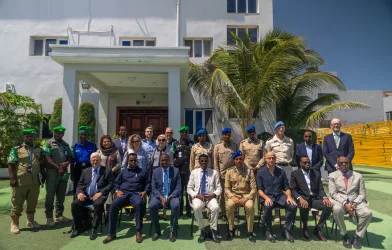
MALINDI, Kenya (AP) — People here have one thing to thank Somali pirates for: Better fishing.
In past years, illegal commercial trawlers parked off Somalia’s coast and scooped up the ocean’s contents. Now, fishermen on the northern coast of neighboring Kenya say, the trawlers are not coming because of pirates.
“There is a lot of fish now, there is plenty of fish. There is more fish than people can actually use because the international fishermen have been scared away by the pirates,” said Athman Seif, the director of the Malindi Marine Association.
On one early morning, as the sun bathed their wooden dhow in a pale yellow, four fishermen jumped out of their rickety 15-foot boat, grabbed a hand-woven straw basket and waded ashore. The basket held the bounty: 175 pounds (80 kilograms) of sailfish, barracuda and red snapper, the haul from a 12-hour night on the ocean. Each fisherman stood to make $12, enough in this town to be considered a decent night’s work.
Fishermen and sportsmen say they’ve been catching more fish than ever. Howard Lawrence-Brown, who owns Kenya Deep Sea Fishing, said fishing stocks over the last year have been up “enormously – across all species.”
“We had the best marlin season ever last year,” said Lawrence-Brown, who owns Kenya Deep Sea Fishing. “The only explanation is that somebody is not targeting them somewhere. … There’s definitely no question about it, the lack of commercial fishing has made a difference.”
Fishermen in the region have seen their incomes and quality of life rise. New boats and better equipment can be seen on the water.
In Malindi, a second-tier tourist town whose tastiest seafood restaurant is called “The Old Man and the Sea,” after the Ernest Hemingway novel, the income of many families is determined by the number of fish caught during a half-day’s turn at sea.
On a recent weekday, fisherman Abdi Ali said he has more money of late to send his kids to high school, which costs money in Kenya. As Ali spoke, a man nearby held up a 2.5-foot (.75-meter), 9-pound (4-kilo) red snapper to motorists on Malindi’s main oceanfront drive in hopes of enticing a sale.
“This year the amount of fish we have caught has been very good. We get about 150 kilograms to 200 and even 300 kilograms, depending on how much we fish,” said Ali. Three hundred kilograms is about 660 pounds.
“There were fish that had disappeared and have come back like the barracuda, oranda, red snapper and other types,” he said. “We are very happy now that there are so many fish.”
Fishermen in Somalia, too, say they’ve seen increased catches. Traders at a Mogadishu fish market are happy because more fish means lower prices, which means more Somalis can afford to buy.
“I remember some days I used to go to the sea early to catch fish and would return with no fish, but nowadays there are plenty. You can catch it everywhere,” said fisherman Bakar Osman, 50. “I do not know the reason but I think the foreign fishing vessels, which used to loot our fish, were scared away by pirates.”
Somali pirates have increased attacks the last two years because of the millions of dollars in ransom they can earn. They currently hold close to a dozen vessels and more than 200 crew hostage. Fishermen here acknowledge the horror of the attacks – they occasionally are harassed by pirates themselves.
Before the pirates came out in big numbers, fishing longliners roamed the coasts, Lawrence Brown said, laying out miles (kilometers) of line.
“They kill everything from the bottom of the ocean to the boat. They run at 22 knots. They can lay their lines for 24 hours, pick them up and get out of there,” he said. “The damage on the sports fishing side is immeasurable.”
A report on pirates this year by the S. Rajaratnam School of International Studies in Singapore said the value of illegal catches from Somalia’s maritime jurisdiction is estimated at between $90 million and $300 million a year, and that foreign fishing vessels hail from all around the world.
The report’s author, Clive Schofield, a research fellow with the Australian Centre for Ocean Resources and Security at the University of Wollongong, called it ironic that nations contributing warships to anti-piracy efforts are in some cases directly linked to the foreign fishing vessels “stealing Somalia’s offshore resources.”
“This situation has led some pirates to justify their actions on basis of illegal foreign fishing activities – styling themselves ‘coastguards’ and characterizing ransom demands as ‘fines,'” the report said. “Without condoning acts of violence at sea, it is clear that the Somalis who hijack shipping off their coast are in fact not the only ‘pirates’ operating in these waters,” it said.
Piracy has not had a huge effect on Kenya’s overall fishing industry, which is not very well developed on the coast, according to the permanent secretary for Kenya’s Ministry of Fisheries Development, Micheni Japhet Ntiba. Kenya has brought in between 5,000 and 7,000 metric tons of fish off its Indian Ocean coast each of the last several years, he said, less than a tenth of Kenya’s yearly catch from Lake Victoria, on Kenya’s western edge.
Piracy “is a negative thing for Kenya fisherman. It’s a negative thing for the Kenyan economy. It’s a negative thing for the western Indian Ocean economy,” Ntiba said. “What I think is important for us is to invest in security so the government and the private sector can invest in the deep sea ocean resources.”
Still, Kenya’s sports fisherman say the pirates appear to have had a hugely positive effect on their industry. Angus Paul, whose family owns the Kingfisher sports fishing company, said that over the past season clients on his catch-and-release sports fishing outings averaged 12 or 13 sail fish a day. That compares with two or three in previous years.
Somali pirates, Paul said, are a group of terrorists, “but as long as they can keep the big commercial boats out, not fishing the waters, then it benefits a lot of other smaller people.”
Source: AP
Kenya fishermen see upside to pirates: more fish
Published: January 13, 2010







